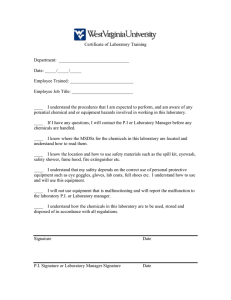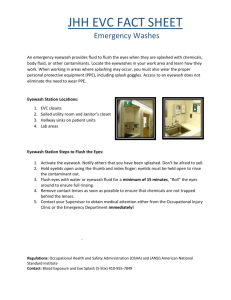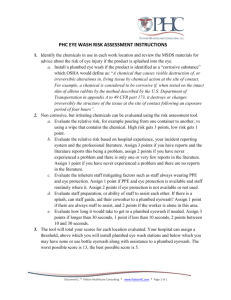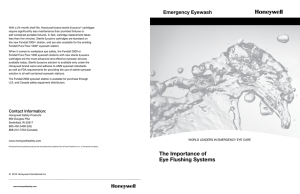Introduction: The Importance of Eye Flushing Systems
advertisement
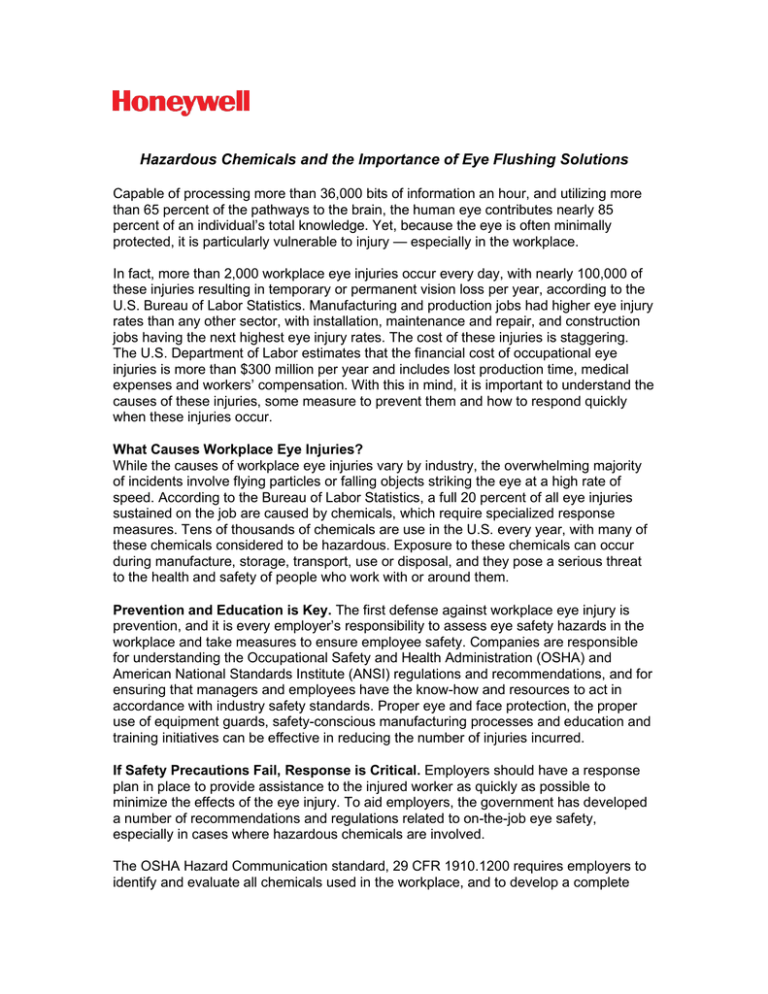
Hazardous Chemicals and the Importance of Eye Flushing Solutions Capable of processing more than 36,000 bits of information an hour, and utilizing more than 65 percent of the pathways to the brain, the human eye contributes nearly 85 percent of an individual’s total knowledge. Yet, because the eye is often minimally protected, it is particularly vulnerable to injury — especially in the workplace. In fact, more than 2,000 workplace eye injuries occur every day, with nearly 100,000 of these injuries resulting in temporary or permanent vision loss per year, according to the U.S. Bureau of Labor Statistics. Manufacturing and production jobs had higher eye injury rates than any other sector, with installation, maintenance and repair, and construction jobs having the next highest eye injury rates. The cost of these injuries is staggering. The U.S. Department of Labor estimates that the financial cost of occupational eye injuries is more than $300 million per year and includes lost production time, medical expenses and workers’ compensation. With this in mind, it is important to understand the causes of these injuries, some measure to prevent them and how to respond quickly when these injuries occur. What Causes Workplace Eye Injuries? While the causes of workplace eye injuries vary by industry, the overwhelming majority of incidents involve flying particles or falling objects striking the eye at a high rate of speed. According to the Bureau of Labor Statistics, a full 20 percent of all eye injuries sustained on the job are caused by chemicals, which require specialized response measures. Tens of thousands of chemicals are use in the U.S. every year, with many of these chemicals considered to be hazardous. Exposure to these chemicals can occur during manufacture, storage, transport, use or disposal, and they pose a serious threat to the health and safety of people who work with or around them. Prevention and Education is Key. The first defense against workplace eye injury is prevention, and it is every employer’s responsibility to assess eye safety hazards in the workplace and take measures to ensure employee safety. Companies are responsible for understanding the Occupational Safety and Health Administration (OSHA) and American National Standards Institute (ANSI) regulations and recommendations, and for ensuring that managers and employees have the know-how and resources to act in accordance with industry safety standards. Proper eye and face protection, the proper use of equipment guards, safety-conscious manufacturing processes and education and training initiatives can be effective in reducing the number of injuries incurred. If Safety Precautions Fail, Response is Critical. Employers should have a response plan in place to provide assistance to the injured worker as quickly as possible to minimize the effects of the eye injury. To aid employers, the government has developed a number of recommendations and regulations related to on-the-job eye safety, especially in cases where hazardous chemicals are involved. The OSHA Hazard Communication standard, 29 CFR 1910.1200 requires employers to identify and evaluate all chemicals used in the workplace, and to develop a complete hazard communication program that provides employees with information about hazardous chemicals in their workplace, and training on identification as well as detection of hazardous chemicals. Employers must also provide safety equipment, emergency and first aid procedures required for safe use of chemicals used in the work place and for emergency response if an employee is exposed to a hazardous chemical. This means Emergency Eyewash. OSHA and ANSI on Eyewash Current OSHA guideline 29 CFR 1910.151(c) states, “Where the eyes or body of any person may be exposed to injurious corrosive materials, suitable facilities for quick drenching or flushing of the eyes and body shall be provided within the work area for immediate emergency use.” For specific recommendations, OSHA refers employers to ANSI standard Z358.1. According to ANSI Standard Z358.1, Emergency Eyewash Stations should; 1. Be available in accessible locations within a 10 second walk of the hazard and must be located on the same level as the hazard. ANSI calculates the average person covers a distance of approximately 55 feet in 10 seconds when walking at normal pace. 2. Deliver a 15-minute continuous flow of flushing fluid, which the ANSI standard defines as any potable (drinking) water, preserved water, preserved buffered saline solution or other medically acceptable solutions. Eyewash station should produce a stream of flushing fluid not less than 0.4 gallons per minute for at least 15 minutes with a consistent fluid pressure. 3. Be located in areas where caustic or hazardous substances are present. When in doubt, always check relevant MSDS under the First Aid Section to determine if the chemical or substance in your facility requires 15-minute eye flushing. 4. Have an on-off valve, pull strap or door that is capable of activation in one second or less and activates with one single motion. 5. Be in a location that is free of obstructions that inhibit immediate use. Do not place pallets, barrels or any other articles in front of or blocking the path to the eyewash station. 6. Be identified with a sign so that everyone working in the area can see the eyewash station, knows what it is and how to use it in an emergency. Current Eye Wash Solutions: Traditional Tap Water Simply stated, tap water can introduce additional contaminants into the injured eye. Though tap water is suitable for drinking, it does contain various irritants and contaminants. In fact, a December 2005 survey by the Environmental Working Group (EWG), a nonprofit environmental research and advocacy group based in Washington, DC, found 141 unregulated chemicals and an additional 119 for which the Environmental Protection Agency (EPA) has set health-based limits. Most common among the chemicals found were disinfection by-products, nitrates, chloroform, barium, arsenic and copper. Flushing these harmful elements into an already damaged eye can cause serious secondary injury and possible vision loss. As one of the most sensitive areas of the eye, the cornea, if injured, has a reduced ability to resist an infection from water contaminated with microorganisms, such as Acanthamoeba, Pseudomonas Aeurginosa and Pseudomonas Cepacia, Enteric Bacili, Entamoeba, and E. coli. Emergency eyewash stations can be a source of potential infection unless the stations are regularly maintained and the flushing fluid quality is carefully monitored. Flushing fluid can be contaminated by the use of potable (tap) water containing microorganisms and from bacteria on the walls of water pipes. The lack of turbulent flow, nutrients present in the water, and favorable ambient temperatures (microbes thrive in a broad temperature range of 10 degrees to 45 degrees) all contribute to the growth of infection-causing microorganisms. Plumbed Eyewash Devices have been in use for more than 100 years. Their greatest attribute is the ability to deliver plentiful amounts of flushing liquid. But plumbed fixtures have a significant number of drawbacks — mostly due to the fact that plumbed fixtures use tap water as a rinsing agent. Not only does tap water not match the pH of the eye, but, as previously discussed it could also contain contaminants and microorganisms — both of which could further irritate and injure the eye, potentially leading to serious complications. Plumbed eyewash stations are also expensive to install and impractical to move when plant layouts are modified or production facilities expand. To adhere to the 10second rule, plumbed eyewash stations may need to be added or relocated, which represents a significant cost and time factor. Plumbed units warrant frequent maintenance according to the ANSI standard. Plumbed eyewash units should be activated weekly to flush out sediment build-up and dangerous microbial contaminants due to sitting water. In large plants, maintenance of multiple eyewash units can represent a substantial labor and cost commitment. Self-contained Portable, Tank-Style Eyewash Stations are designed for portability and easy access. Not only are they far less costly than plumbed devices and easier to move when workflow changes, they are also designed to dispense a buffered saline solution that approximates the pH of the human eye at ambient temperatures (typically 60-100° F). However, some important operating and maintenance concerns remain. Many self-contained units are filled with ordinary tap water, which presents certain risks for flushing the eyes. Even though self-contained units are designed to be filled with a buffered, preserved saline solution, many users fill the reservoir with common tap water, which only increases the likelihood of contaminants in the water supply. Regular maintenance is essential, and ANSI standards recommend that inspection and maintenance be carried out in strict accordance with manufacturer’s instructions. That typically involves cleaning, disinfecting and changing the flushing fluid as often as every week with untreated tap water, to every six months with preserved saline solutions. Filler caps, nozzles, basins and drains can be breeding grounds for bacteria and collection points for other harmful elements. If the tank is not thoroughly disinfected, these harmful elements can be left behind to contaminate the new water source. As such, the maintenance of these units can be costly and time-consuming. Sealed-Cartridge Devices feature factory-sealed cartridges that typically contain purified, buffered saline eyewash solution that remains free of bacteria or contamination for up to 24 months. Because these units can only be refilled using factory-sealed replacement cartridges (not filled on-site using bacteria-harboring tap water), they are safer than other self-contained devices. 24-month cartridges minimize maintenance. Unlike plumbed fixtures or other selfcontained portable systems, which require constant and costly maintenance, sealed cartridges last up to two years and take less than five minutes to replace. Sterile Solution represents the future of emergency eyewash. Although sealedcartridge devices represent a superior option for treatment of workplace eye injuries, the units do not offer a 100 percent sterile solution. Recent research has proven that sterile emergency eyewash solutions deliver additional benefits to the patient being treated. The findings were compelling enough to warrant the FDA’s plans to soon enforce regulations on the use of sterile solutions in portable emergency eyewash. Sterile solution offers unmatched safety. When compared to tap water, sterile solution offers the best protection from contaminants and bacteria that could lead to secondary trauma to an injured eye. Because it is sterile and free of contaminants and living microorganisms that can cause secondary infection, sterile solution also reduces the risk of potential liability if eye injury from flushing with contaminated water occurs. Sterile saline solution offers significant advantages over tap water and even the first generation of sealed cartridges produced with purified water. It is buffered to the same pH as the human eye, which is especially important in the case of chemical splashes, when the eye’s pH is disrupted. Because it utilizes a physiologically correct saline solution that is similar to human tears, it can be used for a full 15 minutes without irritation to the eye. Sterile saline solution also maintains its stable pH during all stages of use, including storage and flushing. The Choice is Clear Nothing is more important than an employee’s safety, and a safe working environment should be a top priority for all employers — especially in work environments where hazardous chemicals are present. By following the requirements and recommendation set forth by OSHA and ANSI, employers can be more proactive in ensuring the safety of their workplace and avoiding costly eye injuries. Prevention, training, and preparedness are vitally important to ensure that workers’ are protected, but should an accident occur, having the best and safest emergency equipment and the best flushing fluid available can make all the difference.

